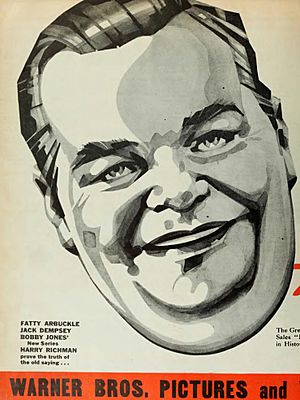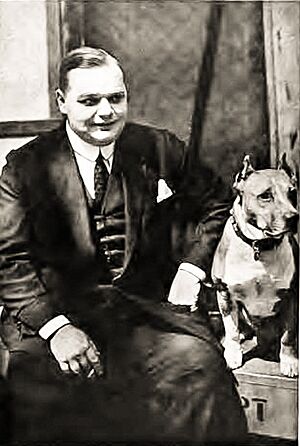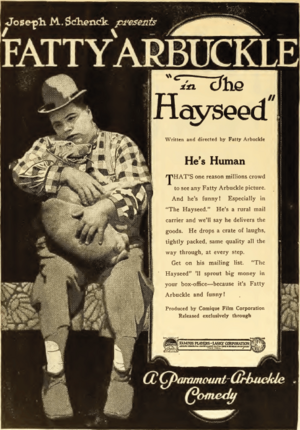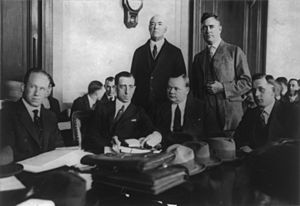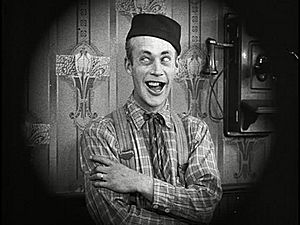Roscoe Arbuckle facts for kids
Quick facts for kids
Roscoe Arbuckle
|
|
|---|---|
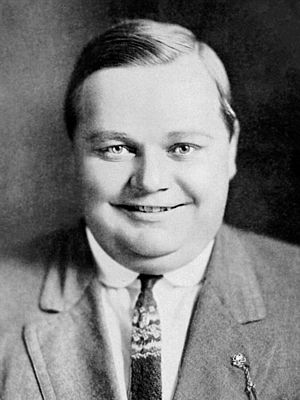
Arbuckle c. 1916
|
|
| Born |
Roscoe Conkling Arbuckle
March 24, 1887 Smith Center, Kansas, U.S.
|
| Died | June 29, 1933 (aged 46) New York City, U.S.
|
| Other names | Fatty Arbuckle, William Goodrich |
| Occupation |
|
| Years active | 1904–1933 |
| Spouse(s) |
Minta Durfee
(m. 1908; div. 1925)Doris Deane
(m. 1925; div. 1929)Addie Oakley Dukes McPhail
(m. 1932) |
| Relatives | Al St. John (nephew) |
Roscoe Conkling "Fatty" Arbuckle (born March 24, 1887 – died June 29, 1933) was an American actor, comedian, director, and screenwriter. He was famous during the silent film era. He started his career at the Selig Polyscope Company. Later, he moved to Keystone Studios.
At Keystone, he worked with stars like Mabel Normand and Harold Lloyd. He also helped start the careers of Charlie Chaplin and Buster Keaton. Arbuckle was one of the most popular silent film stars in the 1910s. He was also one of the highest-paid actors in Hollywood. In 1920, he signed a contract for $1,000,000 a year.
Arbuckle died in his sleep from a heart attack in 1933. He was 46 years old. This happened on the same day he reportedly signed a new movie contract.
Contents
Early Life and First Performances
Roscoe Arbuckle was born on March 24, 1887. His birthplace was Smith Center, Kansas. He was one of nine children. His mother, Mary E. Gordon, had health problems after his birth. She died when Roscoe was eleven.
When Roscoe was almost two, his family moved to Santa Ana, California. He first performed on stage at age eight. He enjoyed performing and continued after his mother's death. His father did not support him, so Roscoe worked odd jobs.
He often sang while working. A professional singer heard him and invited him to a talent show. The audience judged acts by clapping or booing. Bad acts were pulled off stage with a hook. Roscoe sang, danced, and clowned around. He didn't impress the audience at first. When he saw the hook, he somersaulted into the orchestra pit. The audience loved it, and he won the show. This started his career in vaudeville, which was a type of live stage entertainment.
Becoming a Star in Movies
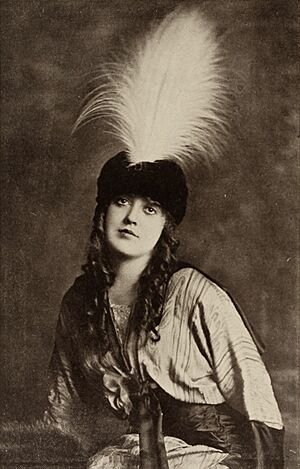
In 1904, Sid Grauman asked Arbuckle to sing in his new theater. This began a long friendship. Arbuckle then joined a touring group called the Pantages Theatre Group. In 1906, he performed in Portland, Oregon. He became the main act, and the group went on tour.
On August 6, 1908, Arbuckle married Minta Durfee. She was also an actress. Minta starred in many early comedy films, often with Roscoe. She was short and small, while Arbuckle weighed about 300 pounds (136 kg). They were a unique pair.
Arbuckle started his film career in July 1909. He appeared in a movie called Ben's Kid. He worked for the Selig Polyscope Company. Later, he moved to Universal Pictures. He became a big star in producer-director Mack Sennett's Keystone Cops comedies.
Even though he was large, Arbuckle was very agile. He didn't want to get "cheap" laughs by getting stuck in doors. He was also a talented singer. A famous opera singer, Enrico Caruso, once told him he could be the second greatest singer in the world.
His Comedy Style
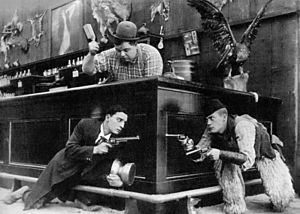
Despite his size, Arbuckle was very athletic. Mack Sennett said he "skipped up the stairs as lightly as Fred Astaire". He could even do a backward somersault gracefully. His comedies were lively and fast-paced. They often had chase scenes and funny sight gags.
Arbuckle was famous for the "pie in the face" joke. This became a classic comedy trick. The first known pie thrown in a film was in 1913. It was in A Noise from the Deep, starring Arbuckle and Mabel Normand.
In 1914, Paramount Pictures made him a huge offer. They offered $1,000 a day plus 25% of profits. He also got complete artistic control. His movies were very popular and made a lot of money. In 1918, Paramount offered him a three-year, $3 million contract.
By 1916, Arbuckle had serious health problems. He had a bad infection on his leg. Doctors even thought about cutting off his leg. He kept his leg but had pain for a long time. After he recovered, Arbuckle started his own film company, Comique. He worked with Joseph Schenck.
Arbuckle didn't like his nickname "Fatty." He said it was "inevitable" because he had been called that since school. Fans also called him "The Prince of Whales." But "Fatty" was mostly the character he played on screen. He preferred people to call him by his real name, Roscoe.
Facing Challenges and Directing Films
Roscoe Arbuckle faced some difficult challenges in his life. These events greatly affected his popularity. Even though he was found innocent in court, he was banned from working in U.S. movies. He worked hard to get his career back.
Because his films were banned, Buster Keaton tried to help him. In 1922, Keaton agreed to give Arbuckle 35% of his company's future profits. This was to help Arbuckle financially.
In November 1923, Minta Durfee filed for divorce from Arbuckle. They had been separated since 1921. But Minta always said he was a very kind man. They remained friends. Arbuckle married Doris Deane in May 1925.
Arbuckle tried to return to filmmaking. But movie companies were still hesitant to release his films. Keaton continued to help him. Arbuckle wrote a story for Keaton's short film Day Dreams (1922). He also helped direct scenes in Keaton's Sherlock Jr. (1924).
In 1925, a short film called Character Studies was released. It was filmed before his challenges. Arbuckle appeared in it with other stars like Keaton and Harold Lloyd. That same year, a magazine writer named James R. Quirk wrote that he wanted to see Arbuckle make a comeback. He asked if Arbuckle was getting a fair chance.
Working as William Goodrich
Eventually, Arbuckle worked as a director. He used the pseudonym "William Goodrich." A pseudonym is a fake name used by a writer or artist. Some say he chose the name from his father's full name, William Goodrich Arbuckle. Others say Buster Keaton suggested "Will B. Good" as a joke. Arbuckle then chose the more formal "William Goodrich."
From 1924 to 1932, Arbuckle directed many comedy short films. He made these for Educational Pictures. These films featured less famous comedians. He also directed bigger movies like Special Delivery (1927) with Eddie Cantor. He also directed The Red Mill (1927) starring Marion Davies.
Second Divorce and Third Marriage
In 1929, Doris Deane divorced Arbuckle in Los Angeles. On June 21, 1932, Roscoe married Addie Oakley Dukes McPhail. They were married in Erie, Pennsylvania.
A Return to Acting and His Final Years
In 1932, Arbuckle signed a new contract with Warner Bros.. He would star in six short comedies. These films were made in Brooklyn, New York. They are the only recordings of Arbuckle's voice. His nephew, Al St. John, and other actors appeared with him.
These short films were very successful in America. However, when Warner Bros. tried to release the first one in the United Kingdom, it was banned. The British film board mentioned his past challenges.
On June 28, 1933, Arbuckle finished filming his last short movie. The next day, he signed a contract for a full-length film. That night, he celebrated his wedding anniversary and the new contract. He reportedly said, "This is the best day of my life." He had a heart attack later that night and died in his sleep. He was 46 years old. His wife, Addie, had his body cremated, as he wished.
His Lasting Impact
Many of Arbuckle's films are still around today. However, some only exist as old copies with foreign language titles. In the early 2000s, some of his short films were restored. They were released on DVD and shown in theaters. His early influence on American slapstick comedy is still recognized. Slapstick comedy uses exaggerated physical actions for humor.
In 1960, 27 years after he died, Arbuckle received a star. It is on the Hollywood Walk of Fame at 6701 Hollywood Boulevard. This honored his contributions to the film industry.
Filmography
See also
 In Spanish: Roscoe Arbuckle para niños
In Spanish: Roscoe Arbuckle para niños
- List of actors with Hollywood Walk of Fame motion picture stars
- List of American comedy films


